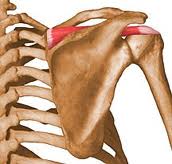The Rotator Cuff

What is the rotator cuff? A group of muscles surrounding the shoulder joint: Supraspinatus: Location: Supraspinous fossa of scapula (shoulder blade) to greater tubercle of humerus (upper arm bone). Basic action: Assists deltoid in abduction (out to the side movement) of the humerus. Infraspinatus: Location: Infraspinous fossa of the scapula to greater tubercle of the humerus. Basic action: Externally rotates (turns out) the humerus. Teres Minor: Location: Lateral border of the scapula to greater tubercle of the humerus. Basic action: Externally rotates the humerus. Subscapularis: Location: Subscapular fossa of the scapula to lesser tubercle of the humerus Basic action: Internally rotates (turns in) the humerus. However these basic actions don’t occur in function as the cuff work together to do something very different! So what does the rotator cuff actually do? Aids movement of the glenohumeral joint (shoulder joint) Comp

